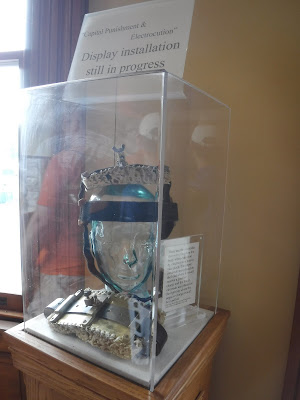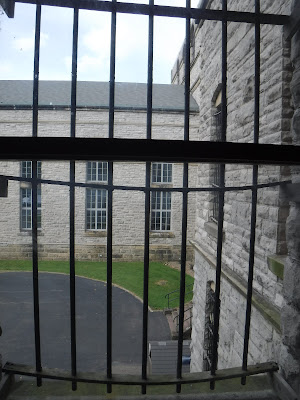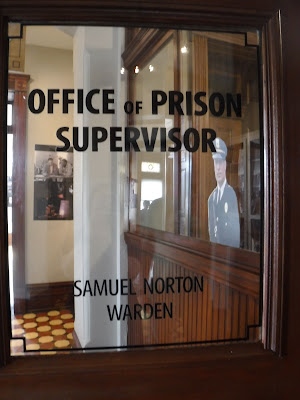This past weekend, I was lucky enough to run in the 5th Annual Shawshank Hustle held at the Ohio State Reformatory. Along with my ticket for the race, I also got a ticket to tour the Reformatory where the movie the Shawshank Redemption was filmed.
Ohio State Reformatory History
The land where the Reformatory was built was first used as a civil war training camp in 1861 before being purchased in 1867 for $1,326,769. Construction took between 1886-1910 for the new Intermediate Penitentiary (original name) and was built to house young first-time offenders. The designer was Levi T. Scofield who was thought that his design would help encourage inmates to become reborn. The architect was F.F. Schnitzer and his name can be found on one of the cornerstones. The name of the Intermediate Penitentiary was changed to Ohio State Reformatory in 1891.
The first 150 offenders were brought to the reformatory on September 15, 1896. The reformatory still is the only prison that has the largest six tier high free standing steel cell block. Over 200 people are on recorded of dying at the reformatory, including two guards who were killed during an escape attempt.
Arthur Lewis Glattke was the Superintendent from 1935 to 1959. His wife, Helen Bauer Glattke, died in November 1950 from pneumonia after she accidentally knocked a handgun to the ground and it discharged while she was reaching into a jewelry box in the family's quarters. Glattke passed on February 10, 1959, after suffering a heart attack at his desk.
The reformatory remained in operation until December 1990 after being ordered to close it's doors by federal court order. A class action suit (known as Boyd Consent Decree) was brought on by the prisoners (Boyd v. Denton, C.A. 78-1054A(N.D.Oh.)) for overcrowding and inhumane conditions.
The cells where built to only house one prisoner at a time but over the years with more and more prisoners, the cells became crowded with doubling or tripling bunks. This caused lots of fights between the inmates and they became crafty with making shanks, shivs, and other items.
Many of the wardens, guards and staff also lived within the Reformatory walls. The Warden's living quarters where located on the east side.
The Mansfield Reformatory Preservation Society was formed in 1995 to turn the prison into a museum. Tours are daily 11 am to 4 pm and tickets are between $13 to $20. We did the self guiding tour but I wish we would have gotten the Audio Wand because I felt like I was missing a lot of the history.
 |
| It is said that if you put a chair in an empty room, it will move on its own. |
My favorite part of the tour was when I saw these stairs. It was on the top floor of the living quarters and right in the middle of the hallway. I was surprised to find the chapel at the top. It was really beautiful. It is said that the guards used this space, not for religious purposes, but for torturing inmates.
James Lockhart (inmate #54673) was housed on the fourth floor in cell #13. He was born in 1938 and died on January 30, 1960 when he committed suicide by stealing turpentine from the prison furniture shop and pouring the liquid over his head before striking a match.
It is said that this room is filled with ghost activity. Objects move around the room and a woman glides across the room. One ghost hunter claims to have captured this woman saying she was a nurse and a prisoner killed her. You may also hear, "I always liked the library."
 |
| This was once the hospital wing but it was changed to the library. |
 |
| Showers |
 |
| Solitary confinement |
 |
| The wash room |
 |
| Underground sewer system. It was dug up so you can see what it was like |
The Shawshank Redemption Movie
In 1993, Hollywood producers decided to use the Reformatory as the backdrop of the movie The Shawshank Redemption, based off of the 1982 Stephen King novel, Rita Hayworth and Shawshank Redemption.
The film was released in 1994 and was a huge disappointment. The budget for filming was $25 million but it only earned $16 million,
largely thanks to being release the same weekend as Forest Gump. On opening night, Frank Darabont, director, and Liz Glotzer, producer,
was the only two people in the 900 seat theater at Cinerama Dome.
A second releasing, however, had the movie receiving multiple award nominations and grossed $58.3 million. In 1995, the movie became the top rented films.
A fun fact about the movie is that former inmates played many of the extra roles during the film.
A fun fact about the movie is that former inmates played many of the extra roles during the film.
In the scene where Brooks feeds a waxworm to his bird, animal control had the crew wait until they found a waxworm that had already died on its own so that they could say no animals were harmed while making the movie.
The pick Andy used to dig the hole was hidden in the bible starting at the chapter which talks about escaping.
A chemist was brought in to test the water that Andy would be crawling
in and was quoted as saying the water "was absolutely lethal." Andy
still did the take and was greeted with a hot shower right after. For
some of the sewer shots, the crew used chocolate syrup thickened with
sawdust for the visual. Some can still smell the chocolate inside the
tunnel.
 |
| The real movie hole used. |


































































No comments:
Post a Comment